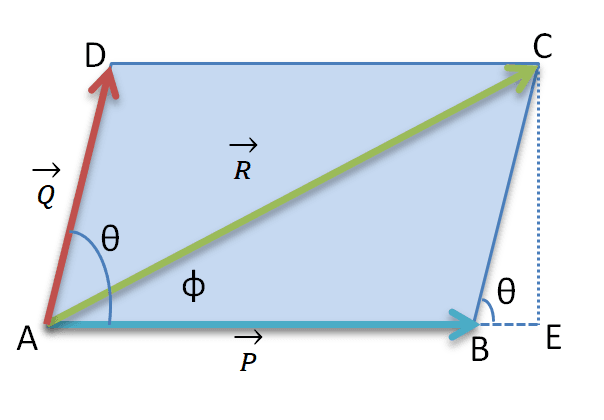Parallelogram law of force enables us to determine the resultant force effective on a body when it is subjected to a system of force consisting of two forces.
This law states that if two forces acting simultaneously be represented in magnitude and direction by the two adjacent sides of a parallelogram, then their resultant is represented in magnitude and direction by the diagonal of the parallelogram drawn from the point of intersection of the two forces.
If two forces, represented by vectors \(\overrightarrow{AB}\) and \(\overrightarrow{AD}\), acting under an angle θ are applied to a body at point A, their action is equivalent to the action of one force, represented by the vector \(\overrightarrow{AC}\), obtained as the diagonal of the parallelogram constructed on the vectors \(\overrightarrow{AB}\) and \(\overrightarrow{AD}\) and directed as shown in the figure
Let us consider a parallelogram ▱ABCD. Two forces \(\mathbf{\vec{P}}\) and \(\mathbf{\vec{Q}}\) be represented by the two sides of the parallelogram AB and AD respectively and the resultant force \(\mathbf{\vec{R}}\) is represented by the diagonal AC.
The force \(\vec{R}\) is called the resultant of the two forces \(\vec{P}\) and \(\vec{Q}\). The forces P and Q are called components of the force R. Thus a force is equivalent to its components, and vice versa.
Let’s extend the line AB and draw a perpendicular line CE on the extension of the line AB .

From traingle \(\triangle BCE\), we can write Sin θ= \(\frac{CE}{BC}\)
Or, CE= BC Sin θ
and again we can write Cos θ= \(\frac{BE}{BC}\)
Or, BE= BC Cos θ
Now from traingle \(\triangle ACE\), we can write
AC2=AE2 + CE2
AC2=(AB+BE)2 + CE2
or, AC2= (AB+ BC cos θ)2 + (BC sin θ)2
or,R2= (P+Q cos θ)2+ Q2sin2θ [As AB= P, AD=BC=Q, and AC= R]
or, R2= P2 +2PQcosθ+Q2cos2 θ + Q2sin2θ
or, R2= P2 +Q2(cos2 θ+sin2θ) +2PQcosθ
or, R2= P2 + Q2 +2PQcosθ (as cos2 θ+sin2θ = 1) …….(i)
R = \(\sqrt{P^{2} + Q^{2} +2PQcosθ }\)
Direction :
Let’s assume the resultant force R is acting at an angle φ with the force P
Now from triangle \(\triangle ACE\), we can write tanφ = \(\frac{CE}{AE}\)
Or, tanφ = \(\frac{CE}{AB + BE}\)
Or, tanφ = \(\frac{BCsinθ}{AB + BCcosθ}\)
tanφ = \(\frac{Qsinθ}{P + Qcosθ}\) (As BC= Q )
Conditions:
- When θ =0° ; when two forces are collinear and are in the same direction.
from equation (i) we get, R2= P2 + Q2 +2PQcosθ
R2= P2 + Q2 +2PQ (as cos0° =1)
R2= (P+Q)2
∴ \(R_{max}\)=P+Q
- When θ =180° ; when two forces are collinear and are in the opposite direction.
from equation (i) we get, R2= P2 + Q2 +2PQcosθ
R2= P2 + Q2 -2PQ (as cos180° =-1)
R2= (P-Q)2
∴ \(R_{min}\)=P-Q
- When θ =90° ; when two forces are normal to each other.
from equation (i) we get, R2= P2 + Q2 +2PQcosθ
R2= P2 + Q2 (as cos90° =0)
∴ R= \(\sqrt{P^{2} +Q^{2}}\)
wohh exactly what I was looking for, regards for posting.